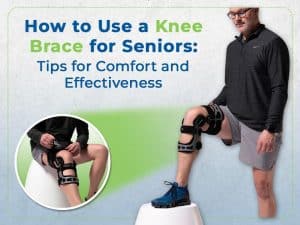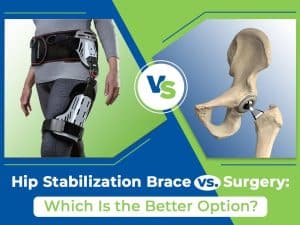Navigating the complex world of healthcare coverage can be daunting, especially when you require essential orthopedic devices like a back brace. Fortunately, Medicare can assist eligible individuals in obtaining a back brace. In this article, we’ll guide you through getting a back brace covered by Medicare, offering valuable insights and tips to ensure a smooth and successful experience.
Understanding Medicare Coverage for Back Braces
Medicare, the federal health insurance program primarily for individuals aged 65 and older, is vital in providing coverage for necessary medical equipment, including back braces. However, it’s essential to clearly understand Medicare’s guidelines regarding back brace coverage to ensure a smooth process.
Medicare typically covers back braces deemed medically necessary by a healthcare provider. This means the brace is prescribed to address specific medical conditions related to the spine or back. These conditions can encompass a range of issues, such as spinal injuries, post-operative support following back surgery, or chronic back pain that requires orthopedic intervention.
To initiate the process of obtaining a back brace through Medicare, a crucial step is obtaining a prescription from your healthcare provider. This prescription is essential because it indicates the medical necessity of the brace and specifies the condition it’s intended to treat or support. Therefore, working closely with your healthcare provider to ensure that the prescription aligns with Medicare’s guidelines is imperative.
Eligibility for Medicare Coverage
One of the critical factors in obtaining coverage for a back brace through Medicare is eligibility. Medicare is designed to provide healthcare coverage to specific groups of individuals, and meeting the eligibility criteria is paramount to accessing its benefits for back braces and other durable medical equipment.

Eligibility process for Medicare coverage of back brace.
- Age-Based Eligibility: The most common route to Medicare eligibility is age-based. Individuals aged 65 and older are generally eligible to enroll in Medicare. This age-based eligibility is often called “Medicare for seniors” based on a person’s age at enrollment.
- Disability Status: In addition to age-based eligibility, individuals under 65 may also qualify for Medicare if they have a disability that meets specific criteria. These disabilities must be recognized by Social Security or the Railroad Retirement Board, and individuals must have received disability benefits for a specific period.
- Specific Medical Conditions: Some individuals may become eligible for Medicare due to specific medical conditions, even if they are under 65. For example, those with end-stage renal disease (ESRD) or amyotrophic lateral sclerosis (ALS) may qualify for Medicare, regardless of their age.
- Enrollment in Medicare Part B: To access coverage for durable medical equipment, including back braces, individuals must be enrolled in Medicare Part B. Medicare Part B is the portion of Medicare that covers outpatient services and medical equipment. It is separate from Medicare Part A, which primarily covers hospital care.
- Premium Considerations: While many individuals 65 and older are automatically enrolled in Medicare Part A, Part B requires monthly premium payments. Understanding the premium structure and payment process is essential for maintaining eligibility for back brace coverage.
It’s important to note that eligibility requirements may evolve, and some individuals may have unique circumstances that affect their eligibility. Therefore, it’s advisable to consult with a knowledgeable healthcare professional or the official Medicare website to determine your specific eligibility status.
Prescription and Medical Necessity
Obtaining a prescription from your healthcare provider is fundamental to securing Medicare coverage for a back brace. This prescription serves as both documentation of medical necessity and a critical element in the claims submission process. To navigate this step effectively, it’s essential to understand the role of the prescription and ensure that it aligns with Medicare’s guidelines.
- Clear Documentation of Medical Necessity: The prescription from your healthcare provider should provide a clear and detailed explanation of the medical necessity for the back brace. It should specify the underlying medical condition that necessitates using the brace. Medicare requires a strong medical rationale to support the need for durable medical equipment like back braces.
- Alignment with Medicare Guidelines: It’s crucial to ensure your healthcare provider knows and adheres to Medicare’s guidelines regarding back brace prescriptions. These guidelines dictate the conditions that warrant a back brace and the associated documentation requirements. Collaboration between you and your healthcare provider in understanding and following these guidelines is vital to a successful outcome.
- Communication with Your Healthcare Provider: Open and transparent communication with your healthcare provider is key. Ensure they are well-informed about your medical history, current condition, and relevant symptoms. This information will assist them in making an accurate diagnosis and determining the medical necessity for a back brace.
- Prescription Details: The prescription should include specific details, such as the type of back brace recommended, the duration for which it is prescribed, and any unique considerations based on your condition. These details will guide the supplier in providing you with the appropriate brace.
- Documentation Retention: Once you have the prescription, it’s important to retain a copy for your records. Documentation is critical throughout the Medicare claims process, and a prescription record ensures you can provide it when needed.
The prescription from your healthcare provider plays a central role in obtaining Medicare coverage for a back brace. It serves as the foundation for establishing the medical necessity of the brace and is essential for claims submission. Ensuring the prescription aligns with Medicare’s guidelines and contains the necessary details is crucial for a smooth and successful process. Effective communication with your healthcare provider and meticulous documentation will contribute to a positive outcome in your quest to secure the back brace you need for improved spinal health and well-being.
Selecting a Medicare-Approved Supplier
One of the key factors in successfully obtaining Medicare coverage for your back brace is choosing a supplier approved by Medicare. Here’s what you need to know about selecting the right supplier:
- Check Medicare Approval: Medicare has a list of approved suppliers for durable medical equipment, including back braces. It’s crucial to choose a supplier that participates in the Medicare program. This ensures they understand the Medicare billing and reimbursement process, increasing the likelihood of a smooth and successful claim.
- Verify Supplier’s Medicare Status: Before acquiring a back brace from a supplier, verify their Medicare approval status. You can do this by contacting Medicare directly or visiting their official website. Additionally, you can inquire with the supplier about their participation in the Medicare program.
- Ask About Experience: Inquire about the supplier’s experience with Medicare claims, especially related to back braces. An experienced supplier is more likely to know the documentation and billing requirements specific to back brace coverage. They can guide you through the process effectively.
Documentation and Claim Submission
To ensure a successful Medicare claim for your back brace, meticulous documentation and proper claim submission are essential:

Medicare Back Brace Documentation and Claim Submission Process.
- Collect Required Documents: Gather all the necessary paperwork before initiating the claim process. This typically includes the prescription from your healthcare provider, relevant medical records or notes supporting the medical necessity of the back brace, and detailed supplier information.
- Prescription: The prescription from your healthcare provider plays a central role in the claim process. It should clearly specify the medical condition for which the back brace is prescribed and why it is medically necessary. When writing the prescription, ensure your healthcare provider knows Medicare’s guidelines for back brace coverage.
- Medical Records: Any additional medical records or notes that provide context and support the need for the back brace are valuable. This documentation helps establish the medical necessity of the brace.
- Supplier Assistance: Your chosen supplier should assist you in submitting the claim to Medicare for reimbursement. They are experienced in navigating the Medicare system and can ensure that all required information is included in the claim.
- Follow-Up: After submitting the claim, it’s advisable to follow up with both the supplier and Medicare to track the progress of your claim. This proactive approach can help address any potential issues promptly.
Selecting a Medicare-approved supplier and diligently managing your documentation and claim submission increases the likelihood of a successful Medicare claim for your back brace. Collaboration with an experienced supplier can significantly streamline the process and ensure you receive the coverage you need for improved back health.
Read More: How to Get Medicare Coverage for Back Braces: Step-by-Step
Appealing a Denied Claim
While the goal is to approve your Medicare claim for a back brace promptly, there may be instances where the initial claim is denied. It’s important to understand that you can appeal the decision in such cases. Here’s how to navigate the appeals process effectively:
- Review the Denial Explanation: When your claim is denied, Medicare will provide an explanation outlining the reasons for the denial. This explanation is valuable for understanding why your claim was not approved. Carefully review this document to identify any specific issues that need to be addressed.
- Consult Your Healthcare Provider: Reach out to your healthcare provider, who prescribed the back brace, to discuss the denial. They can provide additional information or clarification that may support the medical necessity of the brace. Your provider’s expertise is invaluable in building a strong case for appeal.
- Gather Supporting Documentation: If gaps or missing information exist in your initial claim, work with your healthcare provider and supplier to gather necessary documentation. This may include medical records, test results, or additional notes explaining the medical need for the brace.
- Resubmit Your Claim: Once you have addressed the issues that led to the denial, you can resubmit your claim to Medicare. Ensure that all the required documentation and information are included. Keep records of your communication with Medicare and the date of your resubmission.
- Follow-up: After resubmitting your claim, follow up with Medicare to track the status of your appeal. Be persistent and patient throughout this process, as resolution may take some time.
- Consider Professional Assistance: If your appeal is repeatedly denied, you can seek assistance from a Medicare advocate or legal professional specializing in Medicare claims. They can provide guidance and support in navigating the appeals process.
- Know Your Rights: Familiarize yourself with your rights as a Medicare beneficiary. Understanding the appeals process and your entitlements can help you advocate effectively for the coverage you deserve.
It’s important to remain persistent and proactive when appealing a denied claim. Many claims are approved during the appeals process, especially when additional documentation and information are provided to support the medical necessity of the back brace. Your healthcare provider and supplier can be valuable allies in this journey, so keep them informed and engaged throughout the process.
Conclusion
Navigating the process of getting a back brace covered by Medicare may seem daunting, but it can be a manageable endeavor with the right knowledge and guidance. You can increase the chances of a successful claim by understanding the coverage guidelines, ensuring eligibility, obtaining a prescription, selecting an approved supplier, and maintaining accurate documentation. Don’t hesitate to appeal in cases of denial, as your health and well-being are paramount. Medicare is there to support your journey to a more comfortable and pain-free life with the help of a back brace.
Keywords
- Back brace Medicare coverage
- Medicare back brace guidelines
- Getting a back brace through Medicare
- Medicare coverage for orthopaedic devices
- Applying for back brace Medicare
- Medicare-approved back braces
- Medicare eligibility for back braces
- Back brace reimbursement process








